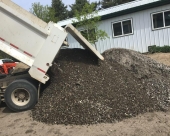Kenneth Elwell wrote:Douglas, the weedy nightmare you describe is in fact another mode of the second "modern" block that Josh Hoffman posted a picture of.
I have seen that block marketed under the name "TurfStone", and seen it in-situ in a municipal park. The idea being that one can create a hybrid lawn/pavement, that from afar looks like lawn, and will support vehicular traffic. It is permeable, and protects the grass in the cells from compaction or "wagon ruts" from traffic.
Fair enough. If it as planted as grass, it needs to be maintained as grass. If it is left as open ground, well nature abhors a vacuum. It won't be long before it is colonized by the usual suspects, requiring maintenance. Though if there is lots of truck and ATV traffic they would continuously chew down any volunteer vegetation.








